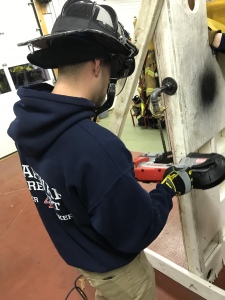Last year, I had the opportunity to present a training on impalements and removal incidents. I had the opportunity to take the P.L. Vulcan class a few years ago and it got me thinking outside the box about using different tools to take care of certain types of scenarios. One of the most important takeaways was the portable bandsaw and what it is able to accomplish compared to other tools like hydraulic cutters and sawzalls. As Mark discussed in his class, some of the best pros include less heat production on the material being cut as well as the smooth transition of the material once cut. A hydraulic cutter will cause the material to pop due to the fracturing of the material. In the case of rebar the material will violently pop and displace compared to little to no movement when cut with the bandsaw. Rescue situations are focused on patient care. It is important to focus on medical elements in conjunction with rescue operations. Being able to determine the severity of injury is vital in determining how much time (the golden hour) and resources may be allotted on scene to get the patient the best chances of survival.

We developed our station using our homemade hose manikin, steel pipe, gate valves, and 1/2″ rebar. Using Mahwah Company 4‘s
ladder bailout simulator we set up two station on the existing prop. On the side we had a single gate valve to allow members to become aware of how the bandsaw will work during a basic cut of rebar.

Under the window we set up another gate with fitting to manipulate the angle of the rebar. The first scenario depicted a patient impaled through his back. Then the patient was stabilized on the window sill via a scoop. The scoop allowed for the patient to be supported while working around the rebar due the center opening of the equipment before being locked in. After EMS took care of packaging the wound and further securing the patient. At that time the rescue crew began the cut on the rebar using the portable bandsaw. As mentioned this created no movement and almost no heat. After as in many EMS scenarios the patient was moved through the window and “transported”.

The second scenario of the night involved a patient being impaled through their leg with the rest of the hips and upper body already through the window. This was done to create a limb impaled on a fence situation. Once again EMS stabilized and padded the rebar in the thigh area. Additionally a basic tourniquet was applied to mitigate a severed femoral artery in the evolution. After the upper body of the patient was supported, the rescue crew began working on the rebar. The bandsaw made the cut with no heat and no movement. This is vital on these types of situations because it creates less potential for further injury.
Flow and Vent was founded by a couple firefighters who believed that there is more to the fire service than just being a t-shirt fireman. It is a page dedicated to providing some tricks to the firefighting trade. We are going to provide you with drills, methods, and insights on things that we have found effective in performing the job. Our administration is made of a breed of young firefighters, raging from all walks of life and completely different departments. However, we have one thing in common, we love the job.



